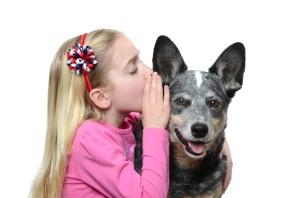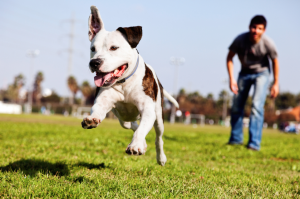 For as long as humans have lived with animals, we’ve fantasized about being able to hold conversations with them. Throughout much of the traditional literature we can find people and animals talking together, from Eve and the serpent in the Book of Genesis to Dr. Doolittle. For those of us old enough to remember, when the animals didn’t talk, they could still understand every word we said. Flipper, Rin Tin Tin, and Lassie were experts in human lingo and would never get confused with their person’s directions. Most of us don’t actually believe our dog can understand our every word, but the assumption that dogs are capable of accurately interpreting at least some elements of human speech is still wildly overrated. Consequently, our expectations as well as our efforts to effectively teach our dogs to respond to verbal commands are often unrealistic. In addition, long held beliefs about dog training have also reinforced our tendency to bark orders to our dog, using our commanding voice whenever we need Fido to obey. But how much can our dog really understand? How can we effectively teach our dog to respond to specific words? Does tone of voice matter when asking for specific behaviors? A few guidelines can truly make a difference and boost our verbal communication with our dog.
For as long as humans have lived with animals, we’ve fantasized about being able to hold conversations with them. Throughout much of the traditional literature we can find people and animals talking together, from Eve and the serpent in the Book of Genesis to Dr. Doolittle. For those of us old enough to remember, when the animals didn’t talk, they could still understand every word we said. Flipper, Rin Tin Tin, and Lassie were experts in human lingo and would never get confused with their person’s directions. Most of us don’t actually believe our dog can understand our every word, but the assumption that dogs are capable of accurately interpreting at least some elements of human speech is still wildly overrated. Consequently, our expectations as well as our efforts to effectively teach our dogs to respond to verbal commands are often unrealistic. In addition, long held beliefs about dog training have also reinforced our tendency to bark orders to our dog, using our commanding voice whenever we need Fido to obey. But how much can our dog really understand? How can we effectively teach our dog to respond to specific words? Does tone of voice matter when asking for specific behaviors? A few guidelines can truly make a difference and boost our verbal communication with our dog.
When a word immediately evokes an image in our head, it’s easy for us to forget that to a dog, a word is simply a sound at first. Without learning and experience, the word has no meaning, no reference to an object, a person or an action. “Sit” does not imply “put your butt on the ground”. To a dog, it holds no more significance than the sound “blah”. So teaching a dog to respond to a cue is like teaching them a foreign language. And to make matters worse, this language has no equivalent in their world. When we think about it, the fact that they can do it at all is actually quite astounding.
Since dogs read our body language so well, we can be fooled into believing that they understand our words better than they actually do. They’ll get all excited when we ask them if they want to go for a walk or if they want a cookie. They might even sit or lie when asked, most of the time. But are we always sure that our pooch is reacting to what we’re saying? Dogs communicate with each other mostly based on body language, so they will naturally tend to pay close attention to what we communicate with our body at the time, and may pay little attention to the sound that we make with our mouth. We might bend over as we say “down” for instance, in which case bending over becomes part of the cue. Sometimes, bending over alone could trigger the dog into lying down, when the word “down” on its own may not elicit any reaction whatsoever.
 So how do we help the dog associate a particular word with an action or an object? Consistent repetition. It can take 50 to 100 repetitions of a particular word said while the dog performs an action, for the dog to make the connection between the two. In other words, we need to say “sit”, while the dog is engaged in the act of sitting, and repeat this sequence enough times for the dog to eventually associate the word “sit” with the action of ‘putting his butt on the ground’. We could just as well say “table”, “blah-blah” or use a foreign language, to the dog it won’t make any difference. In the same way, if we say “Sit, sit, SIT! I said SIT”, that’s the sound we’re teaching the dog to associate with the action. Consequently, our dog won’t respond to “sit”, but will put his butt on the ground for “Sit, sit, SIT! I said SIT”. Now lets think of all the times the dog hears “down”, while he/she is jumping on us, “come” when chasing a squirrel or “give” when running away with a dirty sock. What associations are we teaching our dog then?
So how do we help the dog associate a particular word with an action or an object? Consistent repetition. It can take 50 to 100 repetitions of a particular word said while the dog performs an action, for the dog to make the connection between the two. In other words, we need to say “sit”, while the dog is engaged in the act of sitting, and repeat this sequence enough times for the dog to eventually associate the word “sit” with the action of ‘putting his butt on the ground’. We could just as well say “table”, “blah-blah” or use a foreign language, to the dog it won’t make any difference. In the same way, if we say “Sit, sit, SIT! I said SIT”, that’s the sound we’re teaching the dog to associate with the action. Consequently, our dog won’t respond to “sit”, but will put his butt on the ground for “Sit, sit, SIT! I said SIT”. Now lets think of all the times the dog hears “down”, while he/she is jumping on us, “come” when chasing a squirrel or “give” when running away with a dirty sock. What associations are we teaching our dog then?
Before we go any further on the subject, let’s consider the question of tone of voice. In my 30 years of working with dogs, I’ve rarely come across a dog guardian who doesn’t lower her pitch and slightly raise her voice when asking the dog to ‘obey’. When it comes to vocalizations, most species, including dogs and humans use lower pitch sounds to convey threat, superiority and dominance (Vannoni & Mc Elligott, 2008). Higher pitch sounds on the other hand, are used in low stress situations and non-threatening interactions, like between parents and their offspring (Knutson & al., 2002). Of course the context in which these sounds are used also carries information about the intentions of the individual making those sounds. A new study evaluated the importance of tone of voice and words when a dog is scolded for touching a bowl of food. After placing the dogs in different conditions of scolding (with or without scolding tone of voice, with or without actual words being said), they found that the dogs were least likely to eat the food when they heard the normal human scolding recording, than in any other condition. Overall, the quality of the vocalization, the tone of voice made a big difference in the dog’s reaction to the situation (Gibson & al., 2014).
 So the question is this: when it comes to teaching dogs to respond to words, do we want the dogs to comply because they feel threatened or scolded or do we want them to respond to a word because they enjoy it? If low pitch sounds are threatening to a dog, it’s the equivalent of barking commands, “do as I say, or else…!” When commanded, some dogs may comply while other may freeze and hesitate to offer a behavior. On the other hand, if we use high pitch tones of voice we’re taking pressure off the dog, merely giving a cue, a chance to do something to get a reward. Without the added stressor, the dog has a better chance to think about what is asked of him and make a decision. Most of all, the dog can have fun, enjoy the interaction and feel excited about training. With good technique, there really is no need to command the dog, quite the contrary, dogs are happy to respond to a happy and light “sit” or even a whisper. Dogs could just as well respond to a hand signal or a symbol that conveys no emotional information. If you’re relying on your tone of voice for compliance, you might want to look into the dynamics at play and make some changes for better efficiency.
So the question is this: when it comes to teaching dogs to respond to words, do we want the dogs to comply because they feel threatened or scolded or do we want them to respond to a word because they enjoy it? If low pitch sounds are threatening to a dog, it’s the equivalent of barking commands, “do as I say, or else…!” When commanded, some dogs may comply while other may freeze and hesitate to offer a behavior. On the other hand, if we use high pitch tones of voice we’re taking pressure off the dog, merely giving a cue, a chance to do something to get a reward. Without the added stressor, the dog has a better chance to think about what is asked of him and make a decision. Most of all, the dog can have fun, enjoy the interaction and feel excited about training. With good technique, there really is no need to command the dog, quite the contrary, dogs are happy to respond to a happy and light “sit” or even a whisper. Dogs could just as well respond to a hand signal or a symbol that conveys no emotional information. If you’re relying on your tone of voice for compliance, you might want to look into the dynamics at play and make some changes for better efficiency.
Here are some of the proven techniques used by professional dog trainers:
- Get the behavior first! If the word doesn’t provide any helpful information to the dog, what good does it do us to say it when the dog doesn’t have a clue what we’re teaching her? The first step is to get the dog to figure out what behavior gets rewarded. It’s easy to get a dog into a sit or a down position through luring or shaping techniques (or a combination of both).
- Once the dog systematically gets into the position on her own, say the word (or other cue like a hand signal or a symbol) as the dog initiates the position. So when you notice your dog starting to lower her rear end, say “sit” in a light tone of voice. Simply repeat this over and over. You’ll know that your dog has connected the cue with the behavior, when you can say “sit” while she’s standing and she immediately putts her butt on the ground.
- Practice the behavior in many different situations and in many different positions to allow the dog to learn that the cue has the same meaning in all those situations. This also teaches the dog that the cue is the only constant signal (you can train from standing up, sitting in a chair, sitting on the floor, raising your hands above your head, etc)
- Use your cues wisely. Until the connection between the cue and the behavior is solid, be very careful when you use the cues. Remember, the behavior that the dog is performing will be associated with the cue, so if you’re not sure the dog is ready to sit when a visitor walks through the door, don’t say “sit” as he’s jumping up. Keep the dog on leash and manage the situation in other ways. Keep practicing until the response is strong enough to use in every situation, regardless of distractions.
- Be consistent with your cues. Use the same cues for the same behaviors. “Down” means lie down on the ground, not ‘get off the couch’ or stop jumping on me’ too. In the same way, you’ll want to say “down” every time, not “lie down” or “lay” at others. Clear, distinct and consistent cues will make it a lot easier for the dog.
- Avoid repeating the cue if the dog doesn’t respond. That’s how “sit” turns into “sit, sit, SIT! I said sit”. Allow the dog time to respond and look for the signs that the dog might be confused, distracted, unmotivated, scared, in pain, etc.
- Do not correct the dog if the dog either doesn’t respond or offers a different behavior. Even a ‘non reward marker’ (NRM) like an “oops” introduces pressure in the situation and will be felt as a correction (positive punishment). Instead of being an opportunity for something pleasant, the cue now has the potential to lead to something unpleasant. The dog may hesitate and build resistance to the cue. When that happens, you might need to teach the dog a new cue for that particular behavior.
In the end, for the dog to learn the significance of certain words, we simply need to repeat the same words in the same situations enough times that an association between the two can develop. This also applies to every day life situations. If we say the word “hurry” every time the dog goes to the bathroom, after a number of repetitions, the dog will go to the bathroom on command (a necessary behavior for service dogs). In the same way, “let’s go for a walk”, “get off the couch” or “where’s the ball?” can be learned over time when repeated in the same situations. Consistency and repetitions are key to effective teaching.
Jennifer Cattet Ph.D.




Of course, ” to [human infant] a word is simply a sound at first. Without learning and experience, the word has no meaning, no reference to an object, a person or an action.”
There is a lot of literature as to how important it is the talk to infants even to language learning in utero, as well as the importance of gesture associated with speech to help with language acquisition.
If we spoke to our own babies as we are generally advised to speak to our dogs, our children would have very poor language skills.
If we talk to our dogs as we generally speak to our babies and toddlers, most dogs are quite capable of an enormous amount of language comprehension.
This is the URL which is appropriate to my previous post. I have kept it separate to avoid trouble 🙂
http://www.sciencedaily.com/releases/2014/02/140213142235.htm
Psychologist shows why talking to kids really matters